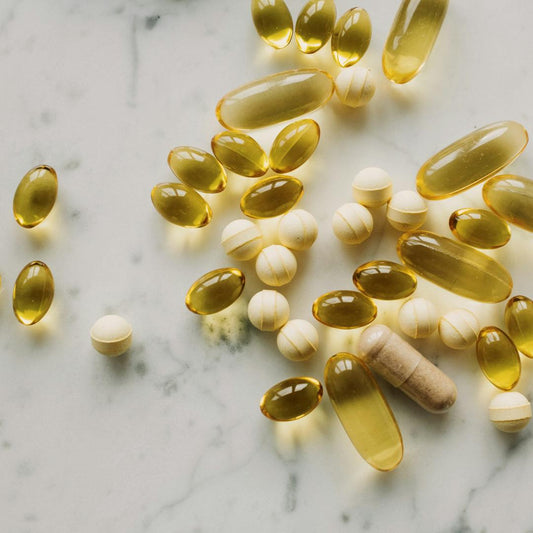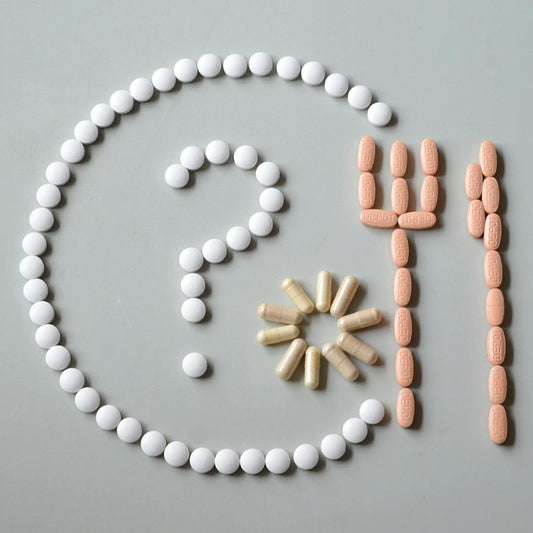
How Much Omega 3 is in Fish Oil?
How Much Omega 3 is in Fish Oil?
We talk about fish oil and the health benefits that come with it, but omega 3, an ingredient that’s found in fish oil, is the real MVP. Omega 3 fatty acids can benefit just about every aspect of our health and wellness, from our heart health to our vision.
So, when you’re choosing fish oil supplements, one of the most important things to look for is the omega 3 content. But how much omega 3 is in fish oil, and how much do you need to be taking each day? That’s what we’re going to talk about today!
We’ll explore how much omega 3 is in fish oil capsules, and how you can choose the right fish oil supplements to make sure you’re getting the vital omega 3 fatty acids your body needs. Here’s what you need to know!
Overview of Omega 3 Supplements
Before we talk about how much omega 3 is in fish oil, let’s take a look at omega 3 supplements and the health benefits of essential omega 3 fatty acids. You’ll soon see why these fatty acids are such a critical part of your diet!
What are Omega 3 Fatty Acids?
Omega 3 fatty acids are a family of polyunsaturated fats crucial for various physiological functions within the human body. The three primary types of omega 3 fatty acids include alpha-linolenic acid (ALA), eicosapentaenoic acid (EPA), and docosahexaenoic acid (DHA).
While ALA is primarily found in plant-based sources like flaxseeds and walnuts, EPA and DHA are predominantly sourced from fatty fish and fish oil supplements. ALA is an essential fatty acid, which means the body can’t generate it at all - it has to come from our diet.
We can generate very small amounts of EPA and DHA by converting ALA into these omega 3 fatty acids, but not enough to meet our body’s needs, which is why EPA and DHA are also a critical part of our diet.
Benefits of Omega 3 Fatty acids
What are the benefits of omega 3 fish oil? The health benefits of with omega 3 fatty acids are very well-researched. Many people use omega 3 fish oil for brain fog, as EPA and DHA are critical components of brain cell membranes, playing an important role in cognitive function, memory, and mood regulation.
Omega 3 fatty acids have also been shown to support cardiovascular health by reducing triglyceride levels, lowering blood pressure, and decreasing the risk of heart disease. There’s also ongoing research into omega 3 fish oil and cholesterol - it looks like these fatty acids can lower cholesterol.
EPA and DHA have powerful anti-inflammatory properties, which is why omega 3 fish oil for inflammation is commonly recommended for arthritis patients and other inflammatory conditions like inflammatory bowel disease.
Is fish oil good for dry eyes? Yes! DHA is also abundant in the retina, where it contributes to visual development and maintenance. Adequate intake of omega 3 fatty acids may help preserve vision and protect against age-related macular degeneration.
There are also omega 3 fish oil benefits for skin, benefits of fish oil for hair, and many benefits of fish oil during pregnancy for both expecting mothers and their developing fetuses. Many women also take omega 3 fish oil for fertility, as it may improve reproductive health and increase their chances of falling pregnant.
Common Sources of Omega 3
When it comes to fish oil vs omega 3, it’s important to understand the differences between the two. Many fish oil supplements contain omega 3, which is really the ingredient you should be looking for. So where can you find omega 3 fatty acids?
While fish oil supplements are a popular means of obtaining omega 3 fatty acids, there are also other ways to incorporate these essential nutrients into your diet. Fatty fish such as salmon, mackerel, trout, and sardines are among the richest sources of EPA and DHA.
Plant-based sources like flaxseeds, chia seeds, hemp seeds, and walnuts provide ALA, which can be converted into EPA and DHA, albeit less efficiently than direct consumption of these fatty acids - consuming ALA alone generally won’t lead to the production of enough EPA and DHA.
Although EPA and DHA can be found in fatty fish, many people prefer to take supplements instead. There are a few reasons for this, the first being that it’s easier to understand how much omega 3 is in fish oil when it’s written on a bottle for you! This way, you know whether you’re getting enough.
Also, many people simply don’t like the taste, smell, or texture of fatty fish, and opt for supplements instead. And, while some fish and seafood comes with the risk of high levels of contaminants like mercury, high-quality fish oil supplements have been carefully purified to remove such contaminants.
How Much Omega 3 is in Fish Oil?
So, how much omega 3 is in fish oil capsules? It’s important to understand the levels of omega 3 in your supplements, as this is where all the health benefits of fish oil are hiding. Here’s what you need to know.
Factors Affecting Omega 3 Content in Fish Oil Supplements
The omega 3 content of fish oil supplements can vary significantly based on several factors. First of all, different species of fish contain varying concentrations of EPA and DHA. For instance, oily fish like salmon and mackerel tend to have higher omega 3 levels than lean fish species.
The method used to extract and process fish oil can impact its omega 3 content. Cold-pressed or molecular distillation methods may preserve more omega 3 fatty acids compared to heat-based extraction methods, which may actually break down omega 3 fatty acids.
The best omega 3 fish oil supplements also undergo rigorous purification processes to remove contaminants like heavy metals and pollutants, which can reduce the omega 3 concentration of your supplements and may also cause serious health issues.
Typical Concentration of Omega 3 Fatty Acids in Fish Oil
So, how much omega 3 is in fish oil capsules? The concentration of EPA and DHA can vary among different fish oil products. Generally, a standard fish oil capsule may contain anywhere from 300 to 1,500 milligrams of combined EPA and DHA per serving.
Reading Labels to Determine EPA and DHA Content
300 to 1,500 mg of combined EPA and DHA is obviously a huge range, which is why it’s so important to read the label of your supplements to make sure they contain high levels of omega 3s. Otherwise, you’re pretty much wasting your money!
Comparing Fish Oil’s Omega 3 Concentration to Other Sources
While fish oil supplements are renowned for their omega 3 content, it's worth comparing their concentration to other dietary sources. So, how much omega 3 is in fish oil compared to a serving of fatty fish like salmon or mackerel?
One serving of wild salmon contains around 1,800 mg of combined EPA and DHA, which is slightly more than a high-quality fish oil supplement. However, cooking methods can lower this content, and it also becomes very expensive to eat that much fresh fish every day!
Mackerel and sardines also have similar levels of EPA and DHA to salmon, but as we mentioned earlier, relying on regularly eating fish for your omega 3 fatty acid content also means you’re potentially consuming high levels of contaminants like mercury and other heavy metals.
Plant-based sources are less effective. Although certain foods like flaxseeds and walnuts contain high levels of ALA, which our bodies can convert to EPA and DHA, this process isn’t very efficient, and we only end up with small amounts of EPA and DHA this way.
So, fatty fish are the best dietary source of omega 3 fatty acids, but it’s an expensive way to get your daily omega 3s, and involves a lot of preparation and cooking (which can also reduce the EPA and DHA content). That’s why supplements are so popular - they’re quick, easy, and oh so effective!
Choosing the Right Omega 3 Fish Oil Supplement to Get Enough Fatty Acids
So, we’ve explained why omega 3 fish oil supplements are the best way to get your daily EPA and DHA, but it’s important to understand that not all supplements contain the omega 3 fatty acids our bodies need. Follow these tips to make sure you’re only buying fish oil supplements that deliver!
Evaluating Purity and Quality
Opt for fish oil supplements that undergo stringent purification processes to remove contaminants like heavy metals, PCBs, and dioxins. This increases the EPA and DHA content, and also protects you against the harmful effects of these contaminants.
Wondering how to tell if your fish oil is good quality? A big part of it depends on the quality of the fish to begin with. Choose supplements made from wild-caught, sustainable fish - they contain higher levels of EPA and DHA and fewer contaminants to worry about.
Assessing Manufacturing Process
Learning how fish oil is made is very important when you’re choosing the right supplements. There are several different methods of extracting and purifying omega 3s from fish oil, and some are more effective than others.
Look for omega 3 fish oil supplements that are manufactured using molecular distillation - this increases the concentration of EPA and DHA while also removing impurities and contaminants.
Comparing Cost to Value
While cost is a factor, prioritize value over price alone. Calculate the cost per serving and assess the concentration of EPA and DHA relative to the price. Opt for supplements that offer a balance between affordability and omega 3 potency, ensuring you get the fatty acids you need without breaking the bank.
The Smell and Taste Test
Fish oil supplements often carry a distinctly fishy odor and taste, which can be off-putting for some. If you’re not a fan of this, opt for supplements that are flavored (naturally) to reduce the “fishiness” smell and taste of your supplements.
Reading User Reviews
One of the best ways to find quality fish oil supplements is by reading reviews from shoppers just like yourself. Find products with lots of positive reviews, and if possible, look for reviews where buyers see real health benefits - this is a sign you’re getting the right supplements!
Get 1000mg of Omega 3 in the #1 Fish Oil Supplement Online at Smarter Vitamins!
At Smarter Vitamins, we’ve worked tirelessly to develop the most effective, potent omega 3 fish oil supplements. Using molecular distillation, we’ve crafted high-purity supplements with triple-strength EPA and DHA.
Our omega 3 fish oil 1000mg contains a combined 1,400 mg of EPA and DHA, ensuring you’re unlocking all the health benefits of these powerful fatty acids. Made right here in the US in an FDA-registered facility, our supplements are free from artificial additives, preservatives, and fillers.
We spent years finding the best possible fish oil from our supplements, which are manufactured from fresh Alaskan wild-catch, sourced sustainably from the pristine waters of the Bering Sea. You won’t find a more natural, potent, pure, effective fish oil supplement anywhere else!
Closing Thoughts on How Much Omega 3 in Fish Oil Capsules
That wraps up our guide on the omega 3 content of fish oil. Hopefully, it’s helped you understand why the omega 3 content is important, and how to find fish oil supplements that are high in critical omega 3 fatty acids like EPA and DHA.
And remember, you can find the purest, most potent, high-omega 3 fish oil capsules here at Smarter Vitamins! With 1,400 mg of combined EPA and DHA, our supplements are the perfect addition to your wellness routine.
Give your body the essential omega 3 fatty acids it needs - shop Smarter Vitamins today!
Get exclusive access to sales, discounts, new product launches, awesome content & more.
Once a month or so.

































